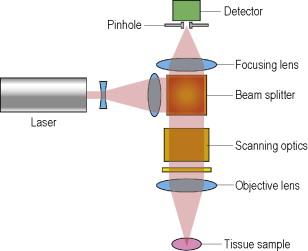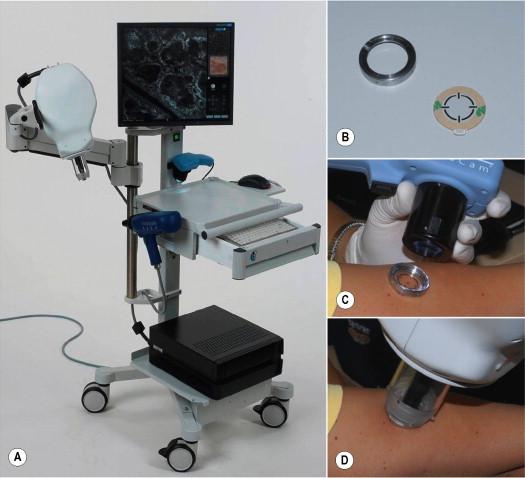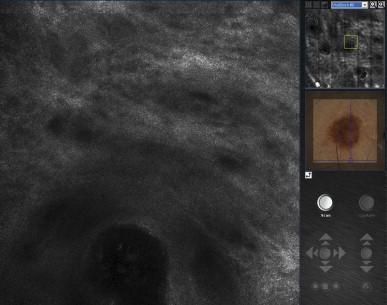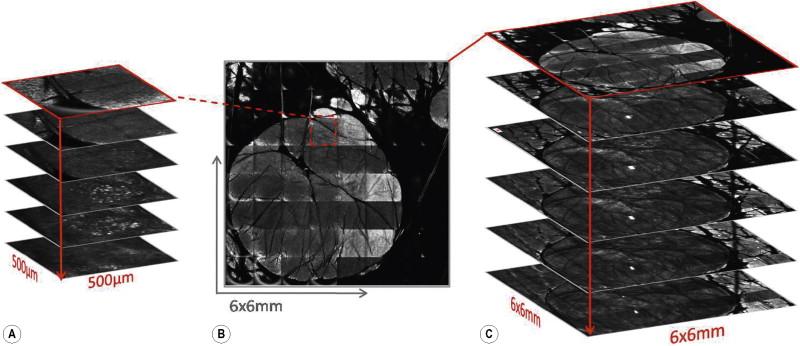Physical Address
304 North Cardinal St.
Dorchester Center, MA 02124
Reflectance confocal microscopy (RCM) enables imaging of skin lesions at cellular-level resolution either at the bedside ( in vivo ) or in freshly excised tissue ( ex vivo ).
Like dermoscopy, in-vivo RCM acquires images in the horizontal plane ( en face ), allowing RCM investigation of tissue pathology underlying dermoscopic structures of interest.
RCM is a promising technique for the non-invasive diagnosis of skin neoplasms as well as for monitoring surgical margins and response to non-invasive treatment.
The search to enhance our clinical diagnosis and to minimize unnecessary skin biopsies has led to the development of non-invasive imaging techniques. Unlike other non-invasive imaging modalities, reflectance confocal microscopy (RCM) offers imaging at cellular-level resolution. RCM imaging can be performed at the bedside – in vivo – or on freshly excised tissue – ex vivo .
In-vivo RCM enables the visualization of epidermis and upper dermis in real-time. While RCM has been applied in a variety of skin conditions, the research focus has been on diagnosis of skin neoplasms. With RCM, optical sectioning of the skin can be performed, like an ‘optical biopsy’; this non-invasive approach is especially desirable for cosmetically sensitive areas such as the face. In addition, RCM enables repeated imaging of the same lesion over time, which can be used for monitoring efficacy of non-invasive treatment. The ability to visualize dynamic processes by RCM (e.g. blood flow) is of great interest for clinical as well as basic dermatological research.
Ex-vivo RCM allows immediate imaging of freshly biopsied tissue with hardly any laboratory processing. Thus, ex-vivo RCM may be used in the future to expedite surgical margin assessment (e.g. during Mohs micrographic surgery).
Confocal scanning microscopy was invented in 1957 by Marvin Minsky at Harvard University. However, only in the 1990s did further advances in optical and electronic technologies allow for the development of an RCM device that could image skin in real-time and that was suitable for clinical applications.
The basic principle of RCM is the use of a point source of light which is tightly focused on a specific point in the tissue. The light is reflected back by certain tissue structures due to variations of refractive indices within the skin; specifically, melanin, hydrated collagen, and keratin are highly reflective skin components which appear brighter on RCM images than the surrounding structures. Only light reflected back from the focus point is allowed to enter the RCM detector through a pinhole-sized spatial filter and be processed by the dedicated software ( Fig. 38.1 ).

RCM uses a near-infrared, low-power laser beam (830 nm diode laser, power up to 35 mW) for imaging ( Fig. 38.2A ). The laser beam is scanned in a two-dimensional grid over the skin to obtain a thin horizontal optical section which is displayed as a gray scale image (500×500 μm field-of-view, Fig. 38.3 ). An automated stepper can be used to obtain up to 256 sequential images making a mosaic grid of 16×16 contiguous images in the horizontal plane ( Fig. 38.4 ). By adjusting the focal length of the laser beam, a series of single images can be stacked vertically at the same point in the tissue ( Fig. 38.4 ). A combination of both imaging settings (mosaicing and stacking) allows for collection of a cube of skin imaging data ( Fig. 38.4 ).



To minimize motion artifacts, an adaptor ring with a disposable polymer window provided with a double-sided adhesive is fixed to the patient's skin and then coupled magnetically to the RCM probe ( Fig. 38.2B,D ). Water-based gel between the probe and window and crodamol oil between the window and skin are used as immersion media. Before RCM imaging, a dermoscopic image, providing a 10×10 mm field-of-view can be captured through the tissue ring with a dedicated camera attached to the RCM ( Fig. 38.2C ). The dermoscopic picture correlates precisely to the RCM mosaic images and can be viewed simultaneously, serving as a gross map to guide RCM imaging of sub-regions of the lesion with a high degree of accuracy ( Fig. 38.3 ).
The RCM is equipped with a 30× water immersion objective lens, providing a 30× magnification for single images and a lateral resolution of 0.5–1 μm. The axial resolution which determines the section thickness is approximately 3–5 μm; this thickness is comparable to the thickness of histological sections. Also comparable to routine histopathology, evaluation of RCM images is usually done first at ‘low magnification’ (e.g. 8×8 mm mosaic similar to 2× magnification in histopathology) to examine the overall lesion architecture and then at ‘higher magnification’ by assessing single RCM images (500×500 μm field-of-view akin to 30× magnification) to further examine architectural and cytomorphological details.
The major limitation of RCM is the limited imaging depth of approximately 250 μm, which usually correlates to the level of the papillary dermis or the upper reticular dermis. Another disadvantage is that assessment of nuclear details with RCM is significantly inferior to assessment with histopathology.
Become a Clinical Tree membership for Full access and enjoy Unlimited articles
If you are a member. Log in here